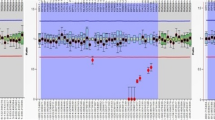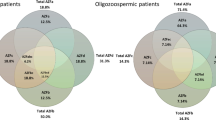Abstract
Reduced male fertility and subfertility can be caused by genetic factors that affect both germ cell development, differentiation, and function; in particular, chromosome abnormalities and Yq microdeletions are a possible cause of spermatogenetic impairment in males as shown by their higher frequency in infertile men than in the general male population. Microdeletion of the long arm of the Y chromosome (Yq) are associated with spermatogenic failure and have been used to define three regions on Yq (AZFa, AZFb, and AZFc) that are critical for germ cell development. With the advent of assisted reproductive technology and intracytoplasmic sperm injection, knowledge about the various factors leading to spermatogenic impairment is one of the most important aspects of scientific research. Therefore, this study was designed to identify the frequency of cytogenetic and submicroscopic interstitial deletions in azoospermia factor loci in infertile Indian males. One hundred and eighty males with nonobstructive oligozoospermia and azoospermia were included in this study. Semen analysis was done in each case to determine the spermatogenic status. Individuals were subjected to detailed clinical examination, family history, and endocrinological and cytogenetic study after consent from the patient. Peripheral blood cultures were set up according to standard protocols and 30 G-banded metaphases were analyzed in each case. Numerical and structural chromosomal abnormalities were detected in 40 infertile cases. Fluorescence in situ hybridization analysis was done in some cases to identify the percentage of mosaic cell lines and any cryptic or low-level mosaicism. Polymerase chain reaction microdeletion analysis was done in 140 cytogenetically normal cases. Of the 140 cases, 8 showed deletion of at least one of the sequence-tagged site markers. Review of literature has shown that the overall frequency of microdeletions varies from 1 to 55%. In the present study, the frequency of microdeletion was 5.8%, and deletions were identified in cases with undescended testis and varicocele and cases with bilateral severe testiculopathy.
Similar content being viewed by others
References
de Kretser, D.M. (1997) Male infertility. Lancet 349, 787–790.
Simoni, M., Bakker, E., and Krausz, C. (2004) EAA/EMQN best practice guidelines for molecular diagnosis of Y-chromosomal microdeletions. State of the art 2004. Int. J. Androl. 27, 240–249.
Vergnaud, G., Page, D. C., Simmler, M.-C., et al. (1986) A deletion map of the hyman Y chromosome based on DNA hybridization. Am. J. Hum. Genet. 38, 109–124.
Vollrath, D., Foote, S., Hilton, A., et al. (1992) The human Y chromosome: a 43 interval map based on naturally occuring deletions. Science 258, 52–59.
Vogt, P.H., Edelmann, A., Kirsch, S., et al. (1996) Human Y chromosome azzospermia factors (AZF) mapped to different subregions in Yq 11. Hum. Mol. Genet. 5, 233–943.
[WHO] World Health Organization (1999) WHO Laboratory Manual for Examination of Human Semen and Cervical Mucus Interaction. 3rd ed. Cambridge: Cambridge University Press.
Simoni, M., Bakker, E., Eurling, M.C.M., et al. (1999) Laboratory guidelines for molecular diagnosis of Y chromosomal microdeletions. Int. J. Androl. 22, 292–299.
McElreavey, K., Rappaport, R., Vilain, E., et al. (1992) A minority of 46,XX true hermaphrodites are positive for the Y-DNA sequence including SRY. Hum. Genet. 90, 121–125.
Dada, R., Gupta, N. P., and Kucheria, K. (2003) Semen cryoconservation in men with AZFc microdeletion. Clin. Genet. 64, 74–75.
Dada, R., Gupta, N. P., and Kucheria, K (2002) AZF microdeletions associated with idiopathic and non-idiopathic cases with cryptorchidism and varicocele. Asian J. Androl. 4, 259–263.
Simoni, M., Gromoll, J., Dworniczak, B., et al. (1997) Screening for deletions of the Y chromosome involving the DAZ (deleted in azoospermia) gene in azoospermia and severe oligozoospermia. Fertil. Steril. 67, 542–547.
Yin, Y., DeWolf, W. C., and Moregentaler, A. (1998) Experimental cryptochidism induces testicular germ cell apoptosis by p53-dependent and independent pathways in mice. Biol. Reprod. 58, 492–496.
Dada, R., Gupta, N. P., and Kucheria, K. (2002) Case report. Cryptorchidism and AZF microdeletion. Asian J. Androl. 4, 148.
Foresta, C., Moro, E., Garolla, A., et al. (1999) Y chromosome microdeletions in cryptorchidism and idiopathic infertility. J. Clin. Endocrinol. Metab. 84, 3660–3665.
Goldstein, M. and Eid, J. (1989) Elevation of intratesticular and scrotal skin surface temperature in men with varicocele. J. Urol. 142, 743–745.
Comhaire, F., Monteyne, R., and Kunnun, M. (1981) Radiologic anatomy of the internal spermatic vein(s) in 200 retrograde venograms. Int. J. Androl. 4, 379–387
Sweeney, T. E., Rozum, J. S., Desjardins, C., and Gore, R. W. (1991) Microvascular pressure distribution in the hamster testis. Am. J. Physiol. 26, 1581–1589.
Sweeney, T. E., Rozum, J. S., and Gore, R. W. (1995) Alteration of testicular microvascular pressures during venous pressure elevation. Am. J. Physiol. 269, 1137–1145.
Hsu, L., Goldstein, M. and Schlege, I. P. N. (1995) The effects of varicocelectomy on serum testosterone levels in infertile men with varicoceles. J. Urol. 154, 1752–1755.
Hudson, R. W., Perez-Morrero, R. A., and Crawford, V. A. (1985) Hormonal parameters of men with varicoceles before and after varicocelectomy. Fertil. Steril. 43, 905–910.
Golomb, J., Vardinon, N., and Homomnal, Z. T. (1986) Development of anti-sperm antibodies in varicocele related infertility with enzyme-liked immunosorbent assay (ELISA). Fertil. Steril. 45, 397–402.
Sharma, R. K, Pasqualotto, F. F., and Nelson, D. R. (1999) The reactive oxygen species-total antioxidant capacity (ROS-TAC) score is a new measure of oxidative stress to predict male infertility. Hum. Reprod. 14, 2801–2807.
Ferlin, A., Moro, E., Onisto, M., Toscano, E., Bettella, A., and Foresta, C. (1999) Absence of testicular DAZ gene expression in idiopathic severe testiculopathies. Hum. Reprod. 14, 2286–2292.
Selva, J., Kanafani, S., Prigent, Y, Poncet, V., and Bergere, M. (1997) Incidence of AZF (azoospermia factor) deletions and familial forms of infertility among patients requiring Intracytoplasmic spermatozoa injection (ICSI). J. Assist. Rep. Genet. 14, 593–595
van Golde, R. J., Wetzels, A. M., and de Graff, R. (2001) Decreased fertilization rate and embryo quality after ICSI in oligozoospermic men with microdeletions in the azoospermia factor c region of the Y chromosome. Hum. Reprod. 16, 289–292.
Vogt, P. H. and Fernandes, S. (2003) Polymorphic DAZ gene family in polymorphic structure of AZFc locus: artwork or functional for human spermatogenesis? APMIS 111, 115–126; discussion 126–127.
Author information
Authors and Affiliations
Corresponding author
Rights and permissions
About this article
Cite this article
Dada, R., Gupta, N.P. & Kucheria, K. Cytogenetic and molecular analysis of male infertility. Cell Biochem Biophys 44, 171–177 (2006). https://doi.org/10.1385/CBB:44:1:171
Issue Date:
DOI: https://doi.org/10.1385/CBB:44:1:171




